Soroya Nazarian learned about hereditary inclusion body myopathy (HIBM), an uncommon muscular disorder that affects the Persian Jewish community, while in Israel on a Hadassah mission about five years ago. There, she met professor Zohar Argov, from the department of neurology at the Hebrew University-Hadassah Medical School in Jerusalem, the researcher who first discovered the rare disease in 1984. Although Nazarian did not know anyone personally affected with HIBM, the self-described “professional volunteer” knew her involvement with Hadassah Southern California put her in a unique position to increase awareness and raise funds for the condition that seemed to unfairly target her community.
Michael Banyan had a more personal reason for adopting HIBM as his cause. About a decade ago, the CEO and founder of an industrial alloy manufacturing company learned that he had the disease.
HIBM, typically strikes in early adulthood, slowly weakening the muscles of the limbs and eventually leading to total disability within one to two decades. Persian Jews are disproportionately stricken by the disease. They have a 5 to 10 percent chance of carrying the gene mutation responsible for HIBM. If both parents are carriers, their children have a 25 percent chance of being affected.
Nazarian and Banyan have become a dynamic duo of the HIBM cause, working jointly and independently to raise funds for research on the disease. The two helped mobilize Hadassah’s six Persian groups to collectively raise close to $350,000 for Hadassah Hospital research on HIBM.
As chair of Hadassah Southern California from 1997 to 1999, Nazarian was also instrumental in bringing the issue to the attention of the national organization. Banyan helped form a chapter of the Iranian American Jewish Federation dedicated to raising funds for HIBM research with the support of Solomon Rastegar, the organization’s president at that time.
These efforts are beginning to pay off. In September, researchers in Israel announced that they had identified the gene that causes HIBM. Dr. Stella Mitrani-Rosenbaum, a scientist at Hadassah-University Hospital on Mt. Scopus and a colleague of Argov’s, was one of the principal researchers to make the discovery. Mitrani-Rosenbaum says the findings give hope for the development of a therapy for the disease.
In the meantime, her laboratory has developed a genetic test to identify those who carry or are affected by the gene, and is working on a test to screen for it during pregnancy. (Those wishing to be tested must do so through a physician or genetic counselor.)
“Without the moral support and the most generous financial help of the Persian community … through Hadassah, it would have taken us significantly more time to achieve our aim,” says Mitrani-Rosenbaum.
HIBM does not solely affect the Persian community. Cases have been detected in Jews from Egypt, Afghanistan and Iraq. Nevertheless, its toll on Persian Jews initially caused Nazarian and others to fear that young Persians might marry outside the community out of fear of passing on the disease. She says this concern has declined now that people understand that the disease is not fatal, and that both parents need to be carriers in order to pass the condition along.
Nazarian commends those who have been willing to make their condition public. Like Banyan, Drs. Daniel and Boback Darvish, brothers who both have HIBM, have also spoken at Hadassah events and were part of the Iranian American Jewish Federation chapter dedicated to HIBM. “They’ve dedicated their lives to educating the community about this disease,” she says.
Banyan, meanwhile, maintains a hectic pace not slowed by HIBM. He commutes from Beverly Hills to his office in Anaheim. Only a slight limp gives any hint of his disease. Although no treatment or cure currently exists, he remains optimistic.
“When we started raising funds for HIBM, research [on the disease] was minimal and genetic research was not nearly as advanced,” he says. “With the speed of technology nowadays, and new discoveries being made every day, development of a therapy for HIBM is not very far off.”




















 More news and opinions than at a Shabbat dinner, right in your inbox.
More news and opinions than at a Shabbat dinner, right in your inbox.